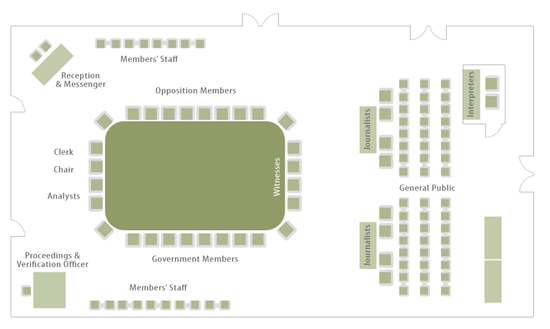- Home
- Letter from the Speaker
- About Members
- The Chamber
- Committees
- Caucuses
- Constituencies
- Representing Canada
- Letter from the Clerk
- Organizational Chart
- Supporting Strategic Objectives
- Conclusion
- Financial Report
- Members of the House of Commons

Committee meetings are another important part of the Members' day. Here Members study issues in depth, calling on expert witnesses and interested citizens to hear their views. Committee meetings largely operate according to the parliamentary calendar, taking place in the same weeks that the Chamber sits; however, committees may sit during recess weeks and even over the summer period. They are scheduled most days of the week between 9:00 a.m. and 7:00 p.m., so Members have to balance their attendance in the Chamber and in committee. During the 2009-2010 fiscal year, 1,091 committee meetings took place.
Committees examine matters that are important to
Canadians. They study proposed legislation, propose
amendments to bills, examine departmental spending and
conduct inquiries into issues that arise in Canada and
around the world. These inquiries can be initiated by a
committee itself or undertaken at the request of the
House. Members of a committee suggest witnesses to
provide information, and people who have information to
share can request to appear in front of the appropriate
committee. Sometimes a committee will travel across the
country to hear from a broader group of interested and
knowledgeable Canadians. Committees usually present a
report to the House at the conclusion of a study. These
reports often contain various recommendations, and
committees can request a comprehensive response from the
government within 120 days. In the past year, committees
presented 186 reports to the House.
During the time of this report, there were 24 standing committees, one special committee and two standing joint committees with the Senate, and several committees struck subcommittees to examine specific issues. In the past fiscal year, committees met for 1,787 hours.
Each committee has 11 or 12 members. Party representation
on committees is based on standings in the House of
Commons. To determine committee membership, the parties
submit lists of candidates to the Standing Committee on
Procedure and House Affairs, which provides a final list
to the House for approval.
Most standing committees are chaired by members of the
governing party; however, 5 of the 26 standing committees
of the 40th Parliament are chaired by a member of the
Official Opposition. Each Chair is assisted by a first
Vice-Chair, who is usually a member of the Official
Opposition, and a second Vice-Chair, who is a member of
an opposition party other than the Official
Opposition.
Members must balance their time in committee with their time in the Chamber. Many sit on more than one committee. Often committee meetings will pause to allow Members to participate in a vote in the Chamber.
Due to their small size, committees provide an opportunity to learn about matters from witnesses and to have in-depth discussions about these topics. They are also a means of ensuring that input from interested parties and experts is placed on the public record. In the past fiscal year, 3,708 witnesses testified at committee meetings. The public can read about the committees and the subjects they studied on the parliamentary Web site at www.parl.gc.ca. Below are some examples of issues studied over the period of this report:
Standing committees are permanent
committees that oversee the activities of government
departments and study proposed legislation and
estimates.
Special committees are appointed by the
House of Commons to inquire into specific matters; a
special committee ceases to exist after it presents a
final report to the House.
Legislative committees study bills
referred to them by the House. A legislative committee
may report a bill back to the House with or without
amendments. The committee ceases to exist once it has
submitted its report to the House.
Joint committees consist of a
proportionate number of Senators and Members of the House
of Commons.
Subcommittees are created by committees. A committee may delegate any or all of its powers to a subcommittee, except the power to report directly to the House of Commons.
Rulings on Procedural Matters in Committee
Committee Chairs are regularly called upon to rule on
procedural matters. When doing so, they usually seek
advice from the clerk of the committee, who often
consults the reference work entitled House of
Commons Procedure and Practice. On occasion,
committee members will ask the clerk to provide
references to the text and may, themselves, use the
book when raising procedural matters in
committee.
Readers of the second edition of this work will find more detailed information about the work of standing, special, legislative and joint committees. The chapter on committees has been expanded and restructured to make it easier to use. The revised chapter, which includes a new section on committee procedure and a number of new tables and graphics, has a more user-friendly presentation that makes it easier to locate supporting references.
Standing Committees
Aboriginal Affairs and Northern Development
Access to Information, Privacy and Ethics*
Agriculture and Agri-Food
Canadian Heritage
Citizenship and Immigration
Environment and Sustainable Development
Finance
Fisheries and Oceans
Foreign Affairs and International Development
Government Operations and Estimates*
Health
Human Resources, Skills and Social Development and the
Status of Persons with Disabilities
Industry, Science and Technology
International Trade
Justice and Human Rights
National Defence
Natural Resources
Official Languages
Procedure and House Affairs
Public Accounts*
Public Safety and National Security
Status of Women*
Transport, Infrastructure and Communities
Veterans Affairs
Special Committees
Special Committee on the Canadian Mission in
Afghanistan
Standing Joint Committees (with the Senate)
Library of Parliament
Scrutiny of Regulations*
*Chaired by a Member of Parliament from the Official Opposition
Committee work for Members and the House Administration does not stop when the meetings end. Members consult with constituents, experts, the House Administration and other Members. The House Administration is assigned specific work by the committee or simply carries out the usual post-committee duties.
